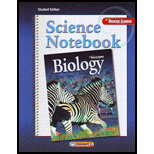
To compare:
The terms in the given table by defining them.
Introduction:
Populations of species are described by density, spatial distribution and growth rate. There are some limiting factors also that keep population from growing indefinitely. They tends to stabilize near the
Answer to Problem 3MI
| Population density- It refers to the number of organisms per unit area. | Dispersion- It refers to the pattern of spacing of a population within an area. |
| Density- independent factor- It refers to any factor in the environment that does not depend on the number of members in a population per unit area. | Density- dependent factor- It refers to any factor in the environment that depends on the number of members in a population per unit area. |
| Emigration- The number of individuals moving away from a population. | Immigration- The number of individuals moving into a population. |
| Carrying capacity- Itis the maximum number of individuals in a species that an environment can support for a long term. | |
Explanation of Solution
Population density- It refers to the number of organisms per unit area.
Dispersion- It refers to the pattern of spacing of a population within an area.There are three main types of dispersion- uniform, random and clumped. One important primary factor in the pattern of dispersion for all organisms is the availability of resources such as food. The limiting factors for spatial distribution are either density- independent factors or density- dependent factors. These factors prevent a population from growing indefinitely.
Density- independent factor- It refers to any factor in the environment that does not depend on the number of members in a population per unit area.Density- independent factors are abiotic and include natural phenomena such as weather events. These include flooding, extreme heat or cold, tornadoes and hurricanes. Human activities like air, water and land pollution can also limit populations.
Density- dependent factor- It refers to any factor in the environment that depends on the number of members in a population per unit area.Density- dependent factors are often biotic such as predation, disease,
Population growth rate- It is defined as the speed at which a population grows. Important features to keep in mind while calculating growth rate are natality and fatality rate. Natality of a population is the birth rate or number of individuals born in a given period of time. Mortality is the number of deaths that occur in a population over a given period of time.
Emigration- The number of individuals moving away from a population.
Immigration- The number of individuals moving into a population. In most instances emigration and immigration are equal.
Carrying capacity- Itis the maximum number of individuals in a species that an environment can support for a long term.It is limited by the energy, water, oxygen and the nutrients available. The number of individual increase till the carrying capacity is reached. Species of organisms vary in the number of births per reproduction cycle, in the age that reproduction begins and in the life span of organisms. Plants and animals are placed in groups based on their reproductive factors.
Additional Science Textbook Solutions
Human Anatomy & Physiology (2nd Edition)
Organic Chemistry (8th Edition)
Chemistry: An Introduction to General, Organic, and Biological Chemistry (13th Edition)
College Physics: A Strategic Approach (3rd Edition)
Campbell Biology (11th Edition)
Introductory Chemistry (6th Edition)
- What is behavioral adaptarrow_forward22. Which of the following mutant proteins is expected to have a dominant negative effect when over- expressed in normal cells? a. mutant PI3-kinase that lacks the SH2 domain but retains the kinase function b. mutant Grb2 protein that cannot bind to RTK c. mutant RTK that lacks the extracellular domain d. mutant PDK that has the PH domain but lost the kinase function e. all of the abovearrow_forwardWhat is the label ?arrow_forward
- Can you described the image? Can you explain the question as well their answer and how to get to an answer to an problem like this?arrow_forwardglg 112 mid unit assignment Identifying melting processesarrow_forwardGive only the mode of inheritance consistent with all three pedigrees and only two reasons that support this, nothing more, (it shouldn't take too long)arrow_forward
- Oarrow_forwardDescribe the principle of homeostasis.arrow_forwardExplain how the hormones of the glands listed below travel around the body to target organs and tissues : Pituitary gland Hypothalamus Thyroid Parathyroid Adrenal Pineal Pancreas(islets of langerhans) Gonads (testes and ovaries) Placentaarrow_forward
- What are the functions of the hormones produced in the glands listed below: Pituitary gland Hypothalamus Thyroid Parathyroid Adrenal Pineal Pancreas(islets of langerhans) Gonads (testes and ovaries) Placentaarrow_forwardDescribe the hormones produced in the glands listed below: Pituitary gland Hypothalamus Thyroid Parathyroid Adrenal Pineal Pancreas(islets of langerhans) Gonads (testes and ovaries) Placentaarrow_forwardPlease help me calculate drug dosage from the following information: Patient weight: 35 pounds, so 15.9 kilograms (got this by dividing 35 pounds by 2.2 kilograms) Drug dose: 0.05mg/kg Drug concentration: 2mg/mLarrow_forward
 Human Anatomy & Physiology (11th Edition)BiologyISBN:9780134580999Author:Elaine N. Marieb, Katja N. HoehnPublisher:PEARSON
Human Anatomy & Physiology (11th Edition)BiologyISBN:9780134580999Author:Elaine N. Marieb, Katja N. HoehnPublisher:PEARSON Biology 2eBiologyISBN:9781947172517Author:Matthew Douglas, Jung Choi, Mary Ann ClarkPublisher:OpenStax
Biology 2eBiologyISBN:9781947172517Author:Matthew Douglas, Jung Choi, Mary Ann ClarkPublisher:OpenStax Anatomy & PhysiologyBiologyISBN:9781259398629Author:McKinley, Michael P., O'loughlin, Valerie Dean, Bidle, Theresa StouterPublisher:Mcgraw Hill Education,
Anatomy & PhysiologyBiologyISBN:9781259398629Author:McKinley, Michael P., O'loughlin, Valerie Dean, Bidle, Theresa StouterPublisher:Mcgraw Hill Education, Molecular Biology of the Cell (Sixth Edition)BiologyISBN:9780815344322Author:Bruce Alberts, Alexander D. Johnson, Julian Lewis, David Morgan, Martin Raff, Keith Roberts, Peter WalterPublisher:W. W. Norton & Company
Molecular Biology of the Cell (Sixth Edition)BiologyISBN:9780815344322Author:Bruce Alberts, Alexander D. Johnson, Julian Lewis, David Morgan, Martin Raff, Keith Roberts, Peter WalterPublisher:W. W. Norton & Company Laboratory Manual For Human Anatomy & PhysiologyBiologyISBN:9781260159363Author:Martin, Terry R., Prentice-craver, CynthiaPublisher:McGraw-Hill Publishing Co.
Laboratory Manual For Human Anatomy & PhysiologyBiologyISBN:9781260159363Author:Martin, Terry R., Prentice-craver, CynthiaPublisher:McGraw-Hill Publishing Co. Inquiry Into Life (16th Edition)BiologyISBN:9781260231700Author:Sylvia S. Mader, Michael WindelspechtPublisher:McGraw Hill Education
Inquiry Into Life (16th Edition)BiologyISBN:9781260231700Author:Sylvia S. Mader, Michael WindelspechtPublisher:McGraw Hill Education





